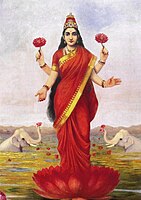| Revision as of 05:37, 24 November 2019 editJohnbod (talk | contribs)Autopatrolled, Extended confirmed users, IP block exemptions, Rollbackers280,477 edits →Form← Previous edit | Revision as of 05:37, 24 November 2019 edit undoJohnbod (talk | contribs)Autopatrolled, Extended confirmed users, IP block exemptions, Rollbackers280,477 edits ''nelumbo nucifera'' the Indian lotusNext edit → | ||
| Line 13: | Line 13: | ||
| <gallery widths="200px" heights="200px"> | <gallery widths="200px" heights="200px"> | ||
| File:HanaNoHasu7.jpg| | File:HanaNoHasu7.jpg|Flower of '']'' the ] | ||
| File:Shiva as the Lord of Dance LACMA.jpg|Restrained lotus throne typical of ], when they have them at all. Shiva ], 10th century. | File:Shiva as the Lord of Dance LACMA.jpg|Restrained lotus throne typical of ], when they have them at all. Shiva ], 10th century. | ||
| File:The Hindu Goddess Parvati LACMA M.77.82 (3 of 12).jpg|Thrones under ], 11th century | File:The Hindu Goddess Parvati LACMA M.77.82 (3 of 12).jpg|Thrones under ], 11th century | ||
Revision as of 05:37, 24 November 2019

In Asian art a lotus throne is a stylized lotus flower used as the seat or base for a figure. It is the normal pedestal for divine figures in Buddhist art and Hindu art, and often seen in Jain art. Originating in Indian art, it followed Indian religions to East Asia in particular.
The precise form varies, but is intended to represent the opening flower of nelumbo nucifera the Indian lotus; in some Buddhist legends the baby Buddha emerged from a lotus flower. The Indian lotus, is an acquatic plant, similar to a water lily, though not actually any close relation. Among other unusual characteristics, nelumbo nucifera has particular properties of repelling water, known as the lotus effect or ultrahydrophobicity. Among other symbolic meanings, it rises above the water environment it lives in, and is not contaminated by it, so providing a model for Buddhists.
In Sanscrit the throne is called either a padmasana, also the name for the Lotus position in meditation and yoga, or padmapitha, padma meaning lotus and pitha a base or plinth.
History
The form is first seen as a base for rare early images of Laxmi from the 2nd century BCE. However it first becomes common with seated Buddha figures in the Greco-Buddhist art of Gandhara around the 3rd century CE. In early Buddhist art it may be intended to specifically depict the second of the Twin Miracles in the legend of the Buddha's life. In some accounts of this, when engaged in a contest with sorcerers, the Buddha multiplied himself into other bodies, which sat or stood on lotus flowers. It became used for other Buddhist figures, and began to be adopted for Hindu deities.
Form
The throne in art evolved to be rather distant from the actual plant. In historic sculpture there is very often a clear dividing line about halfway up; most often petal shapes both rise and fall from this, but sometimes the upper part of the throne attempts to represent the prominent flat-topped seed head as a base for the figure. In East Asian paintings, and also modern Hindu paintings, the lotus throne is often depicted more realistically in terms of its shape (though obviously not its size).
-
 Flower of nelumbo nucifera the Indian lotus
Flower of nelumbo nucifera the Indian lotus
-
 Restrained lotus throne typical of Chola bronzes, when they have them at all. Shiva Nataraja, 10th century.
Restrained lotus throne typical of Chola bronzes, when they have them at all. Shiva Nataraja, 10th century.
-
 Thrones under Parvati, 11th century
Thrones under Parvati, 11th century
-
 Guanyin, 12th-century Japan
Guanyin, 12th-century Japan
-
Apart from the three figures, the pendent foot of this 12th-century Tibetan Mahakala has its own throne
-
 Krishna, the butter thief, ivory, 16th-century India
Krishna, the butter thief, ivory, 16th-century India
-
 Fancy coloured Buddhist throne under a wrathful deity, Ladakh
Fancy coloured Buddhist throne under a wrathful deity, Ladakh
-
 Gaja-Laxmi, Odisha, 18th century
Gaja-Laxmi, Odisha, 18th century
-
 Raja Ravi Varma, Goddess Lakshmi, 1896
Raja Ravi Varma, Goddess Lakshmi, 1896
Notes
- Krishan & Tadikonda, 65; Rodrigues
- Jansen, 18
- Krishan & Tadikonda, 78, note 89
- Moore & Klein, 149; Krishan & Tadikonda, 65
- Krishan & Tadikonda, 67
- Hāṇḍā, Omacanda, Gaddi Land in Chamba: Its History, Art & Culture : New Light on the Early Wooden Temples, 78-79, 2005, Indus Publishing, ISBN 8173871744, 9788173871740, google books
References
- Jansen, Eva Rudy, The Book of Hindu Imagery: The Gods and their Symbols, 1993, Binkey Kok Publications, ISBN 9074597076, 9789074597074, google books
- Krishan, Yuvrajmm, Tadikonda, Kalpana K., The Buddha Image: Its Origin and Development, 1996, Bharatiya Vidya Bhavan, ISBN 8121505658, 9788121505659, google books
- Moore, Albert C., Klein, Charlotte, Iconography of Religions: An Introduction, 1977, Chris Robertson, ISBN 0800604881, 9780800604882, google books
- Rodrigues, H, "The Sacred Lotus Symbol", Mahavidya, 2016